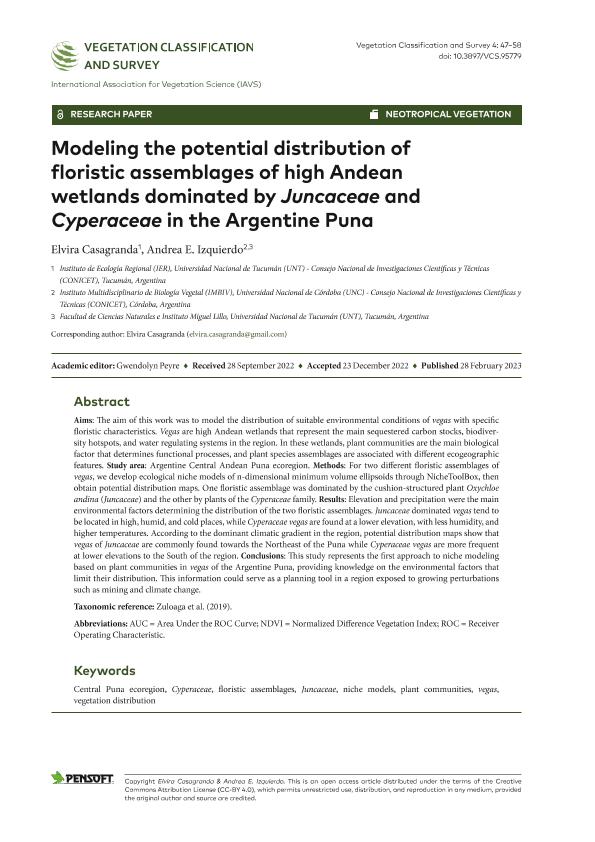Mostrar el registro sencillo del ítem
dc.contributor.author
Casagranda, Maria Elvira

dc.contributor.author
Izquierdo, Andrea Elisa

dc.date.available
2023-12-26T14:00:33Z
dc.date.issued
2023-02-28
dc.identifier.citation
Casagranda, Maria Elvira; Izquierdo, Andrea Elisa; Modeling the potential distribution of floristic assemblages of high Andean wetlands dominated by Juncaceae and Cyperaceae in the Argentine Puna; Pensoft Publishers; Vegetation Classification and Survey; 4; 28-2-2023; 47-58
dc.identifier.uri
http://hdl.handle.net/11336/221388
dc.description.abstract
The aim of this work was to model the distribution of suitable environmental conditions of vegas with specific floristic characteristics. Vegas are high Andean wetlands that represent the main carbon stocks, biodiversity hotspots, and water regulating systems in the region. In these wetlands, plant communities are the main biological factor that determines functional processes, and plant species assemblages are associated with different ecogeographic features. Study area: Argentine Central Andean Puna ecoregion. For two different floristic assemblages of vegas, we develop ecological niche models of n-dimensional minimum volume ellipsoids through NicheTool Box, then obtain potential distribution maps. One floristci assemblage was dominated by the cushion-structured plant Oxychloe andina (Juncaceae) and the other by plants of the Cyperaceae family. Elevation and precipitation were the main environmental conditions determining the distribution of the two floristic assemblages. Juncaceae dominated vegas tend to be located in high, humid, and cold places, while Cyperaceae vegas are found at a lower elevation, with less humidity, and higher temperatures. According to the dominant climatic gradient in the region, potential distribution maps show that vegas of Juncaceae are commonly towards the Northeast of the Puna while Cyperaceae vegas are more frequent at lower elevations to the South of the region. Conclusions: This study represents the first approach to niche modeling based on plant communities in vegas of the Argentine Puna, providing knowledge on the environmental factors that limit their distribution. This information could serve as a planning tool in a region exposed to growing perturbations such as mining and climate change
dc.format
application/pdf
dc.language.iso
eng
dc.publisher
Pensoft Publishers
dc.rights
info:eu-repo/semantics/openAccess
dc.rights.uri
https://creativecommons.org/licenses/by-nc-sa/2.5/ar/
dc.subject
CENTRAL PUNA ECOREGION
dc.subject
CYPERACEAE
dc.subject
FLORISTIC ASSEMBLAGES
dc.subject
JUNCACEAE
dc.subject
NICHE MODELS
dc.subject
PLANT COMMUNITIES
dc.subject
VEGAS
dc.subject
VEGETATION DISTRIBUTION
dc.subject.classification
Otras Ciencias de la Tierra y relacionadas con el Medio Ambiente

dc.subject.classification
Ciencias de la Tierra y relacionadas con el Medio Ambiente

dc.subject.classification
CIENCIAS NATURALES Y EXACTAS

dc.title
Modeling the potential distribution of floristic assemblages of high Andean wetlands dominated by Juncaceae and Cyperaceae in the Argentine Puna
dc.type
info:eu-repo/semantics/article
dc.type
info:ar-repo/semantics/artículo
dc.type
info:eu-repo/semantics/publishedVersion
dc.date.updated
2023-12-13T11:21:48Z
dc.identifier.eissn
2683-0671
dc.journal.volume
4
dc.journal.pagination
47-58
dc.journal.pais
Estados Unidos

dc.description.fil
Fil: Casagranda, Maria Elvira. Universidad Nacional de Tucumán. Facultad de Ciencias Naturales e Instituto Miguel Lillo. Instituto de Ecología Regional; Argentina. Consejo Nacional de Investigaciones Científicas y Técnicas; Argentina
dc.description.fil
Fil: Izquierdo, Andrea Elisa. Consejo Nacional de Investigaciones Científicas y Técnicas. Centro Científico Tecnológico Conicet - Córdoba. Instituto Multidisciplinario de Biología Vegetal. Universidad Nacional de Córdoba. Facultad de Ciencias Exactas Físicas y Naturales. Instituto Multidisciplinario de Biología Vegetal; Argentina
dc.journal.title
Vegetation Classification and Survey
dc.relation.alternativeid
info:eu-repo/semantics/altIdentifier/doi/http://dx.doi.org/10.3897/VCS.95779
Archivos asociados
